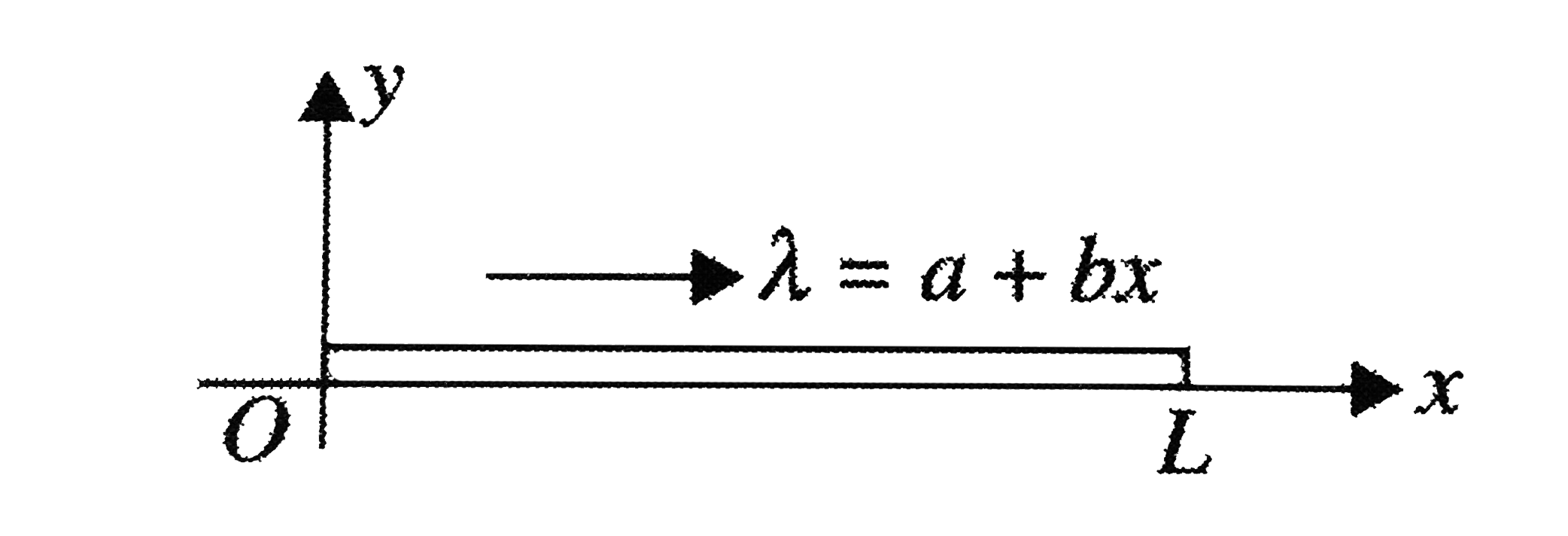A heavy metallic rod of non-uniform mass distribution, is hanged vertically from a rigid support. The linear mass density varies as λ(x)=k×x where x is the distance measured along the length of rod, from its lower end. Find extension in rod due to its own weight.
The correct Answer is:Δl=kgl36AY
To find the extension in a heavy metallic rod of non-uniform mass distribution due to its own weight, we can follow these steps:
1. Define the Linear Mass Density:
The linear mass density of the rod is given by:
λ(x)=kx
where k is a constant and x is the distance from the lower end of the rod.
2. Determine the Mass of an Element:
Consider an infinitesimal element of the rod of length dx at a distance x from the lower end. The mass dm of this element can be expressed as:
dm=λ(x)⋅dx=kx⋅dx
3. Calculate the Weight of the Element:
The weight dW of this infinitesimal mass is given by:
dW=dm⋅g=kx⋅dx⋅g
where g is the acceleration due to gravity.
4. Determine the Force Acting on the Element:
The force F acting on the element due to the weight of the rod above it can be calculated by integrating the weights of all the elements above it. The total weight acting on the element at distance x is:
F=∫LxdW=∫Lxkx′⋅gdx′=kg∫Lxx′dx′
Evaluating the integral:
F=kg(x′22)Lx=kg(L22−x22)=kgL2−x22
5. Calculate the Stress:
The stress σ in the rod at position x is given by:
σ=FA=kgL2−x22A
where A is the cross-sectional area of the rod.
6. Relate Stress to Strain:
Using Young’s modulus Y:
Y=σϵ⟹ϵ=σY
The strain ϵ can be expressed in terms of the change in length δL:
ϵ=dδLdx
7. Express the Change in Length:
Therefore, we can write:
dδL=kg(L2−x2)2AYdx
8. Integrate to Find Total Extension:
To find the total extension δL, integrate from x=0 to x=L:
δL=∫L0dδL=∫L0kg(L2−x2)2AYdx
Evaluating the integral:
δL=kg2AY(L2x−x33)L0=kg2AY(L3−L33)=kgL36AY
9. Final Result:
The total extension in the rod due to its own weight is:
δL=kgL36AY
The linear mass density of the rod is given by:
λ(x)=kx
where k is a constant and x is the distance from the lower end of the rod.
Consider an infinitesimal element of the rod of length dx at a distance x from the lower end. The mass dm of this element can be expressed as:
dm=λ(x)⋅dx=kx⋅dx
The weight dW of this infinitesimal mass is given by:
dW=dm⋅g=kx⋅dx⋅g
where g is the acceleration due to gravity.
The force F acting on the element due to the weight of the rod above it can be calculated by integrating the weights of all the elements above it. The total weight acting on the element at distance x is:
F=∫LxdW=∫Lxkx′⋅gdx′=kg∫Lxx′dx′
Evaluating the integral:
F=kg(x′22)Lx=kg(L22−x22)=kgL2−x22
The stress σ in the rod at position x is given by:
σ=FA=kgL2−x22A
where A is the cross-sectional area of the rod.
Using Young’s modulus Y:
Y=σϵ⟹ϵ=σY
The strain ϵ can be expressed in terms of the change in length δL:
ϵ=dδLdx
Therefore, we can write:
dδL=kg(L2−x2)2AYdx
To find the total extension δL, integrate from x=0 to x=L:
δL=∫L0dδL=∫L0kg(L2−x2)2AYdx
Evaluating the integral:
δL=kg2AY(L2x−x33)L0=kg2AY(L3−L33)=kgL36AY
The total extension in the rod due to its own weight is:
δL=kgL36AY
Topper's Solved these Questions
- MECHANICAL PROPERTIES OF SOLIDSBOOK - AAKASH INSTITUTE ENGLISHCHAPTER - MECHANICAL PROPERTIES OF SOLIDSEXERCISE - EXERCISE
20 Videos
- MECHANICAL PROPERTIES OF SOLIDSBOOK - AAKASH INSTITUTE ENGLISHCHAPTER - MECHANICAL PROPERTIES OF SOLIDSEXERCISE - Assignment(Section-A)
54 Videos
- MECHANICAL PROPERTIES OF SOLIDSBOOK - AAKASH INSTITUTE ENGLISHCHAPTER - MECHANICAL PROPERTIES OF SOLIDSEXERCISE - Assignment (SECTION - I)
4 Videos
- MECHANICAL PROPERTIES OF FLUIDSBOOK - AAKASH INSTITUTE ENGLISHCHAPTER - MECHANICAL PROPERTIES OF FLUIDSEXERCISE - SECTION - J
9 Videos
- Mock test 03BOOK - AAKASH INSTITUTE ENGLISHCHAPTER - Mock test 03EXERCISE - EXAMPLE
44 Videos
Similar Questions
Find coordinates of mass center of a non-uniform rod of length L whose linear mass density lambda varies as lambda=a+bx, where x is the distance from the lighter end.
View SolutionThe linear density of a thin rod of length 1m lies as λ=(1+2x), where x is the distance from its one end. Find the distance of its center of mass from this end.
View SolutionFind centre of mass of given rod of linear mass density λ=(a+b(xl)2) , x is distance from one of its end. Length of the rod is l.
View SolutionThere is a rod of length l , its density varies with length as distance of λ=ax , where x is distance from left end. Find center of mass from left end.
View SolutionThe density of a rod of length L varies as ρ=A+Bx where x is the distance from the left end. Locate the centre of mass.

View SolutionIf linear density of a rod of length 3m varies as λ=2+x, them the position of the centre of gravity of the rod is
View SolutionA heavy uniform rod is hanging vertically from a fixed support. It is stretched by its own weight. The diameter of the rod is
View SolutionThe liner density of a rod of length 2m varies as λ=(2+3x) kg/m, where x is distance from end A . The distance of a center of mass from the end B will be
_PHY_E05_180_Q02.png)
View SolutionA non–uniform thin rod of length L is placed along x-axis as such its one of ends at the origin. The linear mass density of rod is λ=λ0x. The distance of centre of mass of rod from the origin is :
View SolutionYou are given a rod of length L. The linear mass density is λ such that λ=a+bx. Here a and b are constants and the mass of the rod increases as x decreases. Find the mass of the rod

View Solution
